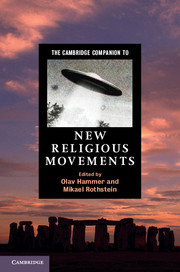Book contents
- Frontmatter
- Introduction to new religious movements
- Part I Social science perspectives
- Part II Themes
- Part III New religious movements
- 8 Scientology: up stat, down stat
- 9 Neopaganism
- 10 The International Raëlian Movement
- 11 The Sathya Sai Baba movement
- 12 Neo-Sufism
- 13 Satanism
- 14 Theosophy
- 15 The New Age
- 16 “Jihadism” as a new religious movement
- 17 New religious movements in changing Russia
- 18 New religious movements in sub-Saharan Africa
- Index
- Other titles in the series
13 - Satanism
from Part III - New religious movements
Published online by Cambridge University Press: 28 September 2012
- Frontmatter
- Introduction to new religious movements
- Part I Social science perspectives
- Part II Themes
- Part III New religious movements
- 8 Scientology: up stat, down stat
- 9 Neopaganism
- 10 The International Raëlian Movement
- 11 The Sathya Sai Baba movement
- 12 Neo-Sufism
- 13 Satanism
- 14 Theosophy
- 15 The New Age
- 16 “Jihadism” as a new religious movement
- 17 New religious movements in changing Russia
- 18 New religious movements in sub-Saharan Africa
- Index
- Other titles in the series
Summary
On June 6, 2006, representatives of the Church of Satan convened in the Steve Allen Theatre in Los Angeles to celebrate a fortieth anniversary High Mass. About a hundred specially invited guests met in a highly mediated affair, showing the world that Satanism was alive and able to push the buttons of the establishment even after forty years of existence. Other groups also took advantage of the apocalyptic date 06–06–06; Twentieth Century Fox, for example, leant heavily on the demonic symbolism of the date when they released the highly anticipated thirtieth-anniversary remake of The Omen worldwide, and many Christian fringe groups speculated on the coming of the Antichrist.
In short, Satan and Satanism constitute a significant presence in popular culture of the Western world. This is hardly inexplicable – Christianity is a powerful cultural presence worldwide, theories of secularization notwithstanding. What is important for the present discussion, however, is the fact that Satanism is not simply inverted Christianity or bloodthirsty Devil worship. As we can see from the various offerings on June 6, 2006, contemporary Satanists are both mythological Christian bogeymen, narrative elements in movies, books, music and other expressions of popular culture, and self-declared individuals and groups claiming to be in league with “Satan” in some way.
- Type
- Chapter
- Information
- The Cambridge Companion to New Religious Movements , pp. 215 - 230Publisher: Cambridge University PressPrint publication year: 2012
- 2
- Cited by

